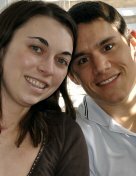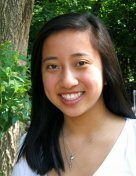She has completed medical school, has won the Flying Pig Marathon and has reached the summit of two of Colorado’s 14,000-foot peaks. Today Dr. Alison Delgado is tackling a mountain of a different kind. Step by hard-earned step, word by remembered word, the young pediatric resident is coming back from a bicycle accident that caused serious physical and neurological injuries. Physicians at the University of Cincinnati Neuroscience Institute have helped her through a series of procedures and treatments, while her husband, Dr. Tim Delgado, has been her No. 1 cheerleader and coach.
Her story of love and survival has attracted a groundswell of media attention, generating coverage from CNN, ESPN, The Today Show, USA Today and the Cincinnati Enquirer.
Alison Delgado was being stabilized at a community hospital following the cycling accident on Oct. 17, 2010, when Tim, an emergency department resident at University Hospital, arrived via Air Care. Tim was to provide assistance to a “Jane Doe cyclist in her 20s” during her transport to University’s trauma center. When Tim realized that the accident victim was his wife, a second helicopter and physician were summoned.
Alison Delgado, who was wearing a bicycle helmet, did not suffer the kind of traumatic brain injury normally seen in bicycle accidents. Although she suffered numerous fractures to her neck and body, her skull was intact. Inside her brain, however, the impact created significant problems. It caused a blood vessel to tear and spill blood into the space around her brain, a subarachnoid hemorrhage. Further, the injury either led to the development of a dangerous aneurysm – a bulge in the blood vessel wall -- or aggravated an existing aneurysm. The discovery of a second aneurysm on the other side of her brain, observed Lori Shutter, MD, Director of UCNI's Neurocritical Care Program, suggested that an underlying physical condition had elevated her risk of developing aneurysms.
During a series of procedures, UCNI’s neurosurgical specialists worked to treat the aneurysm. They tried filling the aneurysm with tiny coils to keep blood from entering, and they tried to bolster the damaged artery with a flexible, mesh stent.
The artery feeding the aneurysm was fragile, however, and the aneurysm continued growing. It ruptured a second time, on November 21, four days after Alison had returned home from her rehabilitation at Drake Center. Once again her husband, Tim, was called to action, only a month after her initial injury.
During her second period of hospitalization, Alison Delgado suffered episodes of vasospasm. The phenomenon occurs when irritating blood byproducts cause the walls of an artery to contract and narrow, reducing blood flow to the brain. During those periods, as Allison experienced stroke-like symptoms and was unable to talk, specialists in the Neuroscience Intensive Care Unit worked to keep her blood pressure up and to keep blood flowing through the constricted artery.
Mario Zuccarello, MD, Chairman of the Department of Neurosurgery and a renowned cerebrovascular surgeon, finally neutralized the aneurysm. He rerouted the blood flow around the damaged artery in a delicate procedure known as an intracranial-extracranial bypass and then shut off blood flow to the aneurysm once and for all with a clip. (He clipped the second aneurysm in early March.)
The worst behind her, Alison was able to focus on rehabilitation and recovery. She progressed rapidly from her lowest point, when she had trouble remembering Tim’s name. They played Uno, Life and Scattergories. Using an iPad, Tim showed her photos and prompted her to search her memory for the words to describe them. Certain words, including “helicopter,” proved elusive at first. Tim also encouraged her to play the video game “Harbor Master,” which hones multitasking skills.
Recovery also has meant daily workouts at the gym. “I do lifting and plyometrics to improve my balance,” Alison said. “At first I had to hold Tim’s hand to do lunges; now I can do them with weights.”
By spring she was reading, though not as quickly as before. Sometimes she groped for the words she wanted to say. Her speech therapist assigned her medical articles to read, then summarize in writing. Alison began attending rounds at Cincinnati Children’s and presented cases of patients at bedside rounds. “Everyone has been great and supportive,” she said.
Dr. Zuccarello wouldn’t let Alison run again until he had clipped the second aneurysm and she had recovered from that surgery. But Tim kept her motivated, and on May 1 she made a triumphant comeback with a third-place finish in the Flying Pig 5k. “We are focused on one goal: getting her back to work and to where she feels normal,” Tim said. “She will feel normal when she gets back to work.”And Tim is keeping her motivated. “We are focused on one goal: getting her back to work and to where she feels normal,” Tim said. “She will feel normal when she gets back to work.”
And then there are the other mountains. There are 54 peaks in Colorado over 14,000 feet, Tim noted. “She wants to get the last 52.”
-- Cindy Starr
 RSS Feed
RSS Feed

